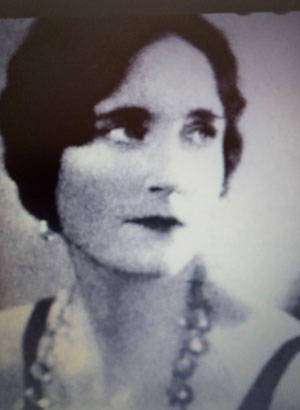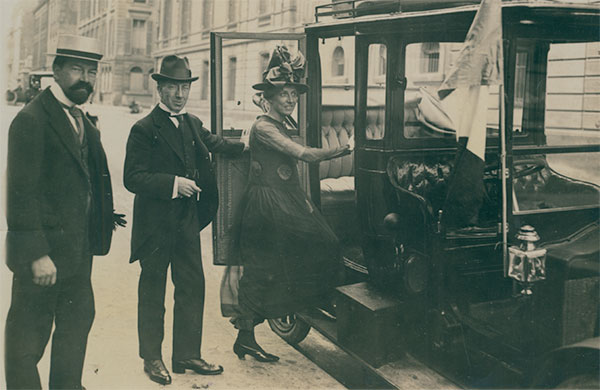By Seán Ryan
Much has been written in recent years about the role of women in the Irish revolutionary period, 1913–23. Many new names have come to prominence and their roles in the momentous events of that time have been well chronicled. Moya Llewelyn Davies, however, is not one of them and an aura of mystery still surrounds her role in the revolutionary movement, her relationship with Michael Collins and her husband’s influence on Collins during the lead-up to the Treaty negotiations in late 1921. She has been variously described as a stalker (by the late Peter Hart in his biography of Collins), as a spy (by Cumann na mBan fellow prisoners in Mountjoy) and as a fantasist (by Margaret Gavan Duffy, wife of the Treaty delegation member). She was certainly a clever, attractive and intelligent woman; as Robert Brennan, director of publicity for Sinn Féin, said of her, ‘Mrs Llewelyn Davies had a great and attractive personality and, like most positive characters, she aroused feelings of admiration and hostility, according to the viewpoint you took’.
Background

Although one would not suspect it owing to her unusual name, Moya Llewelyn Davies had an impeccable nationalist family background. She was born Mary Elizabeth O’Connor on 25 May 1881 in Blackrock, Co. Dublin. She was one of five daughters of James O’Connor (1836–1910), who had been treasurer of the Irish Republican Brotherhood in 1870, was a member of its Supreme Council and had been imprisoned for his activities. He was MP for West Wicklow from 1892 to 1910, originally as an anti-Parnellite, and from 1900 with the reunited Irish Parliamentary Party.
On 30 June 1890 a terrible tragedy occurred, when his wife Mary (34) and four of his daughters, Annie (13), Aileen (10), Kathleen (7) and Norah (5), all died after eating contaminated mussels from the beach in Seapoint, Co. Dublin. Moya only ate a few and became violently ill but survived. The event, known as the ‘Seapoint Tragedy’, caused an enormous outpouring of grief in Dublin and was even referenced by James Joyce in Ulysses when Leopold Bloom remarked, ‘Poor man O’Connor’s wife and five children poisoned by mussels here. The sewage.’
James married for a second time in 1892 but Moya, after an apparent disagreement with her stepmother, Jane McBride, moved to London in 1899. There she joined the civil service and also became a paid speaker for the Liberal Party.
In 1910 Moya married Crompton Llewelyn Davies (1868–1935), a lawyer and Welsh civil servant who had been a friend and close confidant of David Lloyd George, acting as his election agent and sponsor in his early days. Interestingly, Crompton’s two nephews were the basis for the character of Peter Pan by James Barrie. (Michael Collins, whose biographer, Margery Forester, wrote that he had always been a lover of Peter Pan, was to meet Barrie first in 1918 and then on a number of subsequent occasions.)
Crompton Llewelyn Davies was appointed legal adviser to the British Post Office, with access to many of the intelligence-gathering activities of the State. Moya and Crompton had two children, Richard and Catherine, and resided at that time at 55 Campden Hill Road, Kensington, West London. The Llewelyn Davies were very involved in a literary society set in Hans Place in London and their marriage has been described as a happy one.
Radicalisation
Moya was very upset by the executions that followed the Easter Rising in 1916 and from that time became much more interested in the Irish revolutionary movement. From her London home she supported Robert Barton in his successful election campaign in 1918 for her father’s old parliamentary seat in West Wicklow.
She first met Michael Collins in late December 1918, when Collins and other newly elected Sinn Féin TDs (Robert Barton, George Gavan Duffy and Seán T. O’Kelly) travelled to London in an attempt to meet US President Woodrow Wilson. During that visit, Collins and his colleagues attended a reception arranged by an ad hoc Friends of Ireland Committee in the Llewelyn Davies’ home in Kensington. Also present at this reception were John Chartres (who was later to act as a secretary to the Irish Treaty negotiators in 1921), Sir James Barrie (author of Peter Pan, knighted on the recommendation of Lloyd George and a former member of the Secret Service) and Auberon Herbert, Lord Lucas (another Liberal Party member and ex-Secret Service). Given the background of the individuals present, it is not surprising that speculation was aroused about the role of Lloyd George himself in arranging these introductions.
Moya was initially unimpressed by Collins—a ‘bombastic and chain-smoking young man’ was her description of him—but she soon became infatuated with him. Collins was also quite taken with Moya and very soon—on his next journey to England, to arrange de Valera’s escape from Lincoln Jail—he again visited her at her home, bringing with him the key that had been used in the escape.
Moya subsequently decided to move back to Ireland to become more involved in the independence struggle, and in 1920 she purchased Furry Park House, a crumbling mansion in Killester on the north side of Dublin with 40 acres of land. She brought her two children with her; while Crompton remained in England, he visited frequently.
The house was rumoured to have a secret tunnel that led towards the sea at Clontarf, and this may have been a factor in its becoming a ‘safe house’ for the IRA from that time. Certainly, Michael Collins visited quite often and narrowly escaped a raid by British forces in early 1921, when Moya herself was arrested after the discovery of incriminating letters and documents. Imprisoned in Mountjoy Jail, Moya appears to have been given preferential treatment by the authorities and this, coupled with her tendency to ask sensitive questions of her fellow prisoners, gave rise to suspicions that she was a British spy. This view was propagated by several Cumann na mBan members who were in Mountjoy at that time but was dismissed by those in the movement who knew her well and understood her passionate devotion to Ireland. Michael Collins certainly did not believe that Moya was a British spy; he sent bouquets of flowers to her in Mountjoy on several occasions, asking Harry Boland’s sister, Kathleen, to deliver them. After a court martial on 14 June 1921, Moya was released from prison but deported to England. As a consequence, Crompton lost his job with the British Post Office.
Treaty negotiations and Michael Collins
After the truce in July 1921, Moya returned to Dublin and took a room in the Gresham Hotel, where Collins had his headquarters. Crompton was now acting as a paid adviser to Collins and was no doubt in a position to give valuable information regarding Lloyd George and other British establishment figures. In fact, a typescript copy of notes compiled by Crompton on the members of the British delegation was among papers acquired by the National Library of Ireland in 2007 and makes interesting reading. He describes Lloyd George as ‘slippery but with a winning charm’ and advises Collins to appeal to him as a brother Celt. He also has interesting notes on Lord Birkenhead, Winston Churchill and Austen Chamberlain, the other members of the British negotiating team. Crompton also assisted in the drafting of the constitution of the new Free State.
Margaret Gavan Duffy, who had met Moya in London in December 1918 and had found her a clever and attractive person, now—in late 1921—had a very different opinion of her. She found Moya’s talk to be fantastic, making out that she was the centre of the revolutionary movement and full of her own importance.

There has been much speculation about Moya’s relationship with Collins and this was certainly fuelled in part by her own statements. Collins appears to have been attracted to her and spent time in her company, but nothing has ever been categorically established as regards an intimate relationship. Although Moya and Crompton lived apart quite a lot, their marriage appears to have been a happy one. Letters written by Moya in later years have plenty to say about Kitty Kiernan and Lady Hazel Lavery—two other women in Collins’s life—but contain no revelations about her own relationship with Collins. After Collins’s death in August 1922 she withdrew from public life, although this did not prevent her house in Furry Park from being subjected to raids by anti-Treaty republicans (she was fervently pro-Treaty).
Literary work
During her time in Dublin prior to the Truce, Moya was actively involved in writing publicity material for Sinn Féin and the Dáil. She had a keen interest in the Irish language and had been a visitor to the Donegal Gaeltacht in earlier years in the company of the Gavan Duffys, who were keen to have their children brought up as native Irish-speakers. Moya’s father, James, had mastered the language while in prison and in fact conducted lessons in Irish in Dublin’s Mechanics’ Institute, Abbey Street, after his release.
Together with Prof. George Thomson from University College Galway, Moya translated Muiris Ó Súilleabháin’s Fiche Bliain ag Fás into English. Both the Irish and English editions of the book were published together in 1933. Moya’s contribution was principally to take Thomson’s initial translation and rewrite it in a style that retained much of the idiom of the original Irish. She was reputed to have assisted in preparing for publication Collins’s 1922 collection of essays, The path to freedom, and also to have written her autobiography, the manuscript of which has unfortunately disappeared. In 1941 Moya and her daughter moved to Killadreenan House near Newtownmountkennedy, Co. Wicklow. She was diagnosed with cancer and died in hospital on 28 September 1943. She is buried in Deansgrange Cemetery, where her grave was unmarked until 2003, when a memorial was erected.
Seán Ryan is a local historian from Drumcondra.
Further reading
Bureau of Military History: WS 712 (Margaret Gavan Duffy), WS 779 (Robert Brennan), WS 979 (Robert Barton).
M. Forester, Michael Collins—the lost leader (London, 1971).
P. Hart, Mick—the real Michael Collins (New York, 2005).
U. MacEoin, Survivors (Dublin, 1980).
